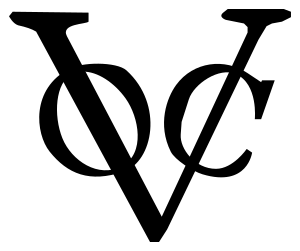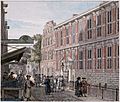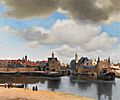Dutch East India Company facts for kids
The Dutch East India Company (also known as the VOC) was a very powerful trading company from the Netherlands. It started in 1602. The Dutch government gave it special permission to be the only company allowed to trade with Asia for 21 years.
The VOC was the first company in the world to be truly global, operating in many countries. It was also the first company to sell stock, which means people could buy small parts of the company. The VOC had amazing powers for a company. It could even start wars, sign treaties, print its own money, and create new colonies.
This company was very important for almost 200 years. But in 1800, it ran out of money and closed down. The lands the VOC controlled in Asia later became a country called Indonesia.
Contents
How the VOC Started (1602-1620)
In the 1500s, most of the trade with Asia was controlled by Portugal. The Dutch government wanted to join the valuable spice trade. Portugal was struggling to meet the high demand for spices in Europe.
So, with money from the government, the VOC set up its first trading post. This was in a place that is now Jakarta, Indonesia. This location soon became the main base for all their operations in Asia.
Growing Bigger and Stronger (1620-1669)
In 1620, the VOC made a trade deal with its main competitor in Asia, the English East India Company. This agreement lasted until 1623. A sad event called the Amboyna Massacre happened, which caused the English company to move its trading posts away from Indonesia.
During the 1620s, the VOC expanded its reach to other Indonesian islands. They started large farms, called plantations, on these islands. This helped them grow and export even more goods. The company kept growing and eventually became the richest company in the world.
In 1640, the VOC opened a trading post in Ceylon, which is now Sri Lanka. This was the last place where Portugal still had a strong presence. After this, the VOC had almost complete control over trade between Europe and Southern Asia.
Exploring Australia
Ships from the VOC were some of the first Europeans to explore the coast of Australia. In 1629, there was a rebellion on the VOC ship Batavia. After the rebellion was stopped, many sailors were punished severely. Two of them, a soldier named Wouter Loos and a cabin boy named Jan Pelgrom de Bye, were left behind. They were dropped off at Wittecarra Gully, near the Murchison River. No one ever saw them again.
Images for kids
-
The "United East India Company", or "United East Indies Company" (also known by the abbreviation "VOC" in Dutch) was the brainchild of Johan van Oldenbarnevelt, the leading statesman of the Dutch Republic.
-
Replica of the VOC ship Duyfken under sail
-
17th century plaque to Dutch East India Company (VOC), Hoorn
-
Return of the second Asia expedition of Jacob van Neck in 1599 by Cornelis Vroom
-
Mughal Bengal's baghlah was a type of ship widely used by Dutch traders in the Indian Ocean, the Arabian Sea, the Bay of Bengal, the Malacca Straits and the South China Sea
-
Dutch East India Company factory in Hugli-Chuchura, Mughal Bengal. Hendrik van Schuylenburgh, 1665
-
Dutch settlement in Bengal Subah.
-
Eustachius De Lannoy of the Dutch East India Company surrenders to Maharaja Marthanda Varma of the Indian Kingdom of Travancore after the Battle of Colachel. (Depiction at Padmanabhapuram Palace)
-
Purchase Contract signed July 5, 1797, between 'Committee for the Affairs of East India Trade and Property' (on behalf of the Batavian Republic) and De Coninck Firm, notarised by Jan Harmsen. Since the VOC had incurred debts of millions, its Indian merchandise in Batavia was sold to the firm. The VOC was unable to send its ships; the firm itself was responsible for collecting the merchandise from Batavia. The merchandise included spices (Nutmeg, Cloves, Black and Brown pepper), dyes (Indigo, Sappan wood, Caliatour wood), Coffee, and Powdered sugar.
-
The Dutch Square in Malacca, with Christ Church (centre) and the Stadthuys (right)
-
Gateway to the Castle of Good Hope, a bastion fort built by the VOC in the 17th century
-
The shipyard of the United East India Company (VOC) in Amsterdam (1726 engraving by Joseph Mulder). The shipbuilding district of Zaan, near Amsterdam, became one of the world's earliest known industrialized areas, with around 900 wind-powered sawmills at the end of the 17th century. By the early seventeenth century Dutch shipyards were producing a large number of ships to a standard design, allowing extensive division of labour, a specialization which further reduced unit costs.
-
Jan Vermeer's View of Delft (ca. 1660–61). During the Dutch Golden Age, the VOC significantly influenced Delft's economy, both directly and indirectly.
-
A replica of the VOC's Halve Maen (captained by Henry Hudson, an Englishman in the service of the Dutch Republic) passes modern-day lower Manhattan, where the original ship would have sailed while investigating New York harbor
-
A typical map from the Golden Age of Netherlandish cartography. Australasia during the Golden Age of Dutch exploration and discovery (c. 1590s–1720s): including Nova Guinea (New Guinea), Nova Hollandia (mainland Australia), Van Diemen's Land (Tasmania), and Nova Zeelandia (New Zealand).
-
Detail from a 1657 map by Jan Janssonius, showing the western coastline of Nova Zeelandia
-
Natives of Arakan sell slaves to the Dutch East India Company, c. 1663 CE.
-
Charles Davidson Bell's 19th-century painting of Jan van Riebeeck, the founder of Cape Town, arriving in Table Bay in 1652
-
The statue of Willem de Vlamingh with the Hartog Plate, Vlieland
-
Monument to the "Tsar-Carpenter" Peter I of Russia (Peter the Great) in St. Petersburg, Russia. In order to learn more about the 17th-century Dutch maritime power, Tsar Peter I came to work incognito as a ship's carpenter at the VOC's shipyards in Amsterdam and Zaandam/Saardam, for a period of four months (1697).
-
The Flying Dutchman by Albert Pinkham Ryder, c. 1887 (Smithsonian American Art Museum). The legend of the Flying Dutchman is likely to have originated from the 17th-century golden age of the VOC.
-
Title page of Hortus Cliffortianus (1737). The work was a collaboration between Carl Linnaeus (Carl von Linné) and Georg Dionysius Ehret, financed by George Clifford III, one of the directors of the VOC.
-
Swedish naturalist Carl Peter Thunberg was a VOC physician and an apostle of Linnaeus.
-
Black swans on the shore of the Swan River (Western Australia), with the Perth skyline in the background. The thousand-year-old conclusion "all swans are white" was disproved by the VOC navigator Willem de Vlamingh's 1697 discovery.
See also
 In Spanish: Compañía Neerlandesa de las Indias Orientales para niños
In Spanish: Compañía Neerlandesa de las Indias Orientales para niños











































